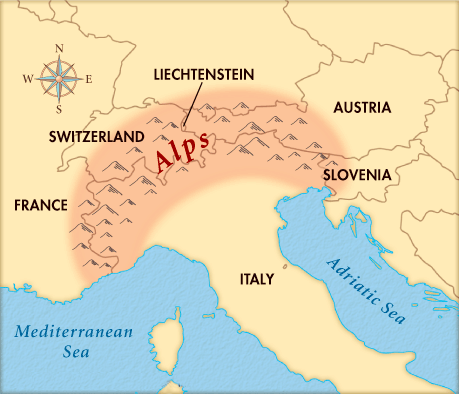Important Facts For Prelims
Glaciers in the Alps are Melting Faster than Ever
- 27 Oct 2022
- 5 min read
Why in News?
- A new study revealed that, in 2022 Switzerland’s glaciers have lost an average of 6.2% of their ice.
What are the Findings?
- Saharan Sand and a Huge Heatwave:
- Across the Alps, the preceding winter had very limited snowfall and therefore glaciers were not well insulated against the forthcoming summer melt season.
- Spring was particularly harsh as natural atmospheric weather patterns carried Saharan dust to Europe and blanketed the Alpine landscape.
- Since dust absorbs more solar energy than snow the now orange-tinted snow melted faster.
- A major heat wave saw temperature records breaking across Europe, with parts of the UK reaching 40° Celsius for the first time.
- The last time glaciers had an extreme melt season was in 2003, when 3.8 % of glacier ice melted across Switzerland.
- Unprecedented Alps Glacier Melt:
- The extent of glacier melting depends on the altitude at which it is located, the steeper the glacier tongue is the heavier it is covered with debris.
- In Switzerland, these glacial meltwaters are used for hydropower.
- Austrian glaciers have also lost more glacial ice in 2022 than they have in 70 years of observations and therefore it is quite clear that severe melt has been the norm in 2022.
- So, one consequence is that melting glaciers help to compensate for low rainfall in times of drought, filling reservoirs to supply the nation’s energy supply.
- Melting glaciers have created more than 1,000 new lakes across the mountains.
- This year, for the first time ever, the frozen ground (Permafrost) that binds rocks together — was thawing and causing almost constant rockfalls.
What are Alps?
- About:
- The Alps emerged during the Alpine orogeny (mountain-building event), an event that began about 65 million years ago as the Mesozoic Era was drawing to a close.
- Alps are young fold mountains with rugged relief and high conical peaks.
- They are the most prominent of western Europe’s physiographic regions. Some 750 miles long and more than 125 miles wide at their broadest point between Garmisch-Partenkirchen, Germany, and Verona, Italy, the Alps cover more than 80,000 square miles.
- The Alps extend north from the subtropical Mediterranean coast near Nice, France, to Lake Geneva before trending east-northeast to Vienna, Austria. There they touch the Danube River and meld with the adjacent plain.
- Because of their arclike shape, the Alps separate the marine west-coast climates of Europe from the Mediterranean areas of France, Italy, and the Balkan region.
- Countries Covered:
- The Alps form part of France, Italy, Switzerland, Germany, Austria, Slovenia, Croatia, Bosnia and Herzegovina, Montenegro, Serbia, and Albania.
- Only Switzerland and Austria can be considered true Alpine countries.
- Important Peaks:
- Mont Blanc is the highest peak in the Alps and in Europe, reaching a lofty 4,804 meters above sea level. It is located in the Graian Alps and lies within France, Switzerland, and Italy.
- Monte Rosa is a massif (a compact group of mountains) consisting of several peaks. The highest peak in this range (Dufourspitze) has an elevation of 4,634 meters, claiming the title of Switzerland’s highest peak.
- Dom, which is located near Monte Rosa, Dom stands at 4,545 meters and is known as one of the “easier” tall peaks in the Alps to summit because of it’s straightforward routes.
- Other major peaks are Liskamm, Weisshorn, Matterhorn, Dent Blanche, Grand Combin etc.
UPSC Civil Services Examination Previous Year Question
Q. How will the melting of Himalayan glaciers have a far-reaching impact on the water resources of India? (2020)
Source: DTE





